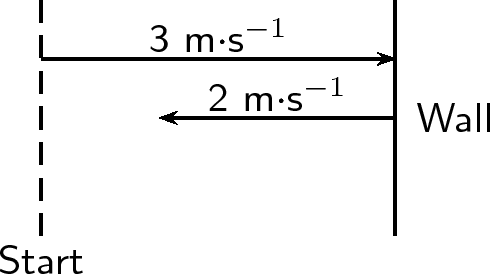| << Chapter < Page | Chapter >> Page > |
Whenever you are faced with adding vectors acting in a straight line (i.e. some directed left and some right, or some acting up and others down) you can use a very simple algebraic technique:
Method: Addition/Subtraction of Vectors in a Straight Line
Let us consider a few examples.
A tennis ball is rolled towards a wall which is 10 m away from the ball. If after striking the wall the ball rolls a further 2,5 m along the ground away from the wall, calculate algebraically the ball's resultant displacement.

We know that the resultant displacement of the ball ( ) is equal to the sum of the ball's separate displacements ( and ):
Since the motion of the ball is in a straight line (i.e. the ball moves towards and away from the wall), we can use the method of algebraic additionjust explained.
Let's choose the positive direction to be towards the wall. This means that the negative direction is away from the wall.
With right positive:
Next we simply add the two displacements to give the resultant:
Finally, in this case towards the wall is the positive direction , so: = 7,5 m towards the wall.
Suppose that a tennis ball is thrown horizontally towards a wall at an initial velocity of to the right. After striking the wall, the ball returns to the thrower at . Determine the change in velocity of the ball.
A quick sketch will help us understand the problem.

Remember that velocity is a vector. The change in the velocity of the ball is equal to the difference between the ball's initial and finalvelocities:
Since the ball moves along a straight line (i.e. left and right), we can use the algebraic technique of vector subtraction just discussed.
Choose the positive direction to be towards the wall. This means that the negative direction is away from the wall.
Thus, the change in velocity of the ball is:
Remember that in this case towards the wall means a positive velocity , so away from the wall means a negative velocity : away from the wall.

Notification Switch
Would you like to follow the 'Siyavula textbooks: grade 10 physical science [caps]' conversation and receive update notifications?